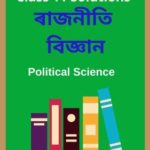Class 11 Political Science MCQ Chapter 9 Constitution as a Living Document Solutions to each chapter is provided in the list so that you can easily browse through different chapters Class 11 Political Science MCQ Chapter 9 Constitution as a Living Document Notes and select need one. Class 11 Political Science MCQ Chapter 9 Constitution as a Living Document Question Answers Download PDF. NCERT Political Science MCQ Class 11 Solutions.
Class 11 Political Science MCQ Chapter 9 Constitution as a Living Document
Also, you can read the NCERT book online in these sections Solutions by Expert Teachers as per Central Board of Secondary Education (CBSE) Book guidelines. AHSEC Class 11 Political Science Part – I and Part – II MCQ Solutions are part of All Subject Solutions. Here we have given NCERT Class 11 Political Science Multiple Choice Notes, Assam Board Class 11 Political Science Objective Type Solutions for All Chapters, You can practice these here.
Constitution as a Living Document
Chapter: 9
| (PART-A) INDIAN CONSTITUTION AT WORK |
| MCQ |
1. The procedural achievement reflects in:
(a) Freedom to criticise the treatment of widows.
(b) Taking decisions in the Constituent Assembly on the basis of reason.
(c) Article 370 and 371
(d) Accepting the importance of the community in an individual life.
Ans: (b) Taking decisions in the Constituent Assembly on the basis of reason.
2. Indian federalism has been constitutional.
(a) Symmetric.
(b) Asymmetric.
(c) Wide.
(d) None of these.
Ans: (b) Asymmetric.
3. Freedom of religion in India means _____________.
(a) Freedom of religion of individuals.
(b) Freedom of religion of communities.
(c) Both (a) and (6) are correct.
(d) None of these.
Ans: (c) Both (a) and (b) are correct.
4. Who argued that a state responsive to the needs of individuals must provide them the means by which their needs are communicated?
(a) Bal Gangadhar Tilak.
(b) Bhagat Singh.
(c) Jawaharlal Nehru.
(d) Rammohan Roy.
Ans: (d) Rammohan Roy.
5. How did the commitment to individual freedom in the Indian Constitution come about?
(a) It emerged miraculously out of calm deliberations around a table.
(b) It was the product of continuous intellectual and political activity of well over a century.
(c) It was forced on the Indian government by the British colonial state.
(d) The author does not provide a reason for this statement.
Ans: (b) It was the product of continuous intellectual and political activity of well over a century.
6. How did the Indian National Congress view individual rights before the adoption of the Constitution?
(a) They viewed individual rights as negotiable.
(b) They viewed individual rights as irrelevant.
(c) They viewed individual rights as a non-negotiable value.
(d) None of these.
Ans: (c) They viewed individual rights as a non-negotiable value.
7. What special measures were provided by the Constitution to protect the interests of Scheduled Castes and Scheduled Tribes?
(a) Reservation of seats in legislatures and public sector jobs.
(b) Reservation of seats in the judiciary.
(c) Reservation of seats in private sector jobs.
(d) None of these.
Ans: (d) Reservation of seats in legislatures and public sector jobs.
8. Which one of the following Fundamental Rights has been ensured to the citizens of India?
(a) To get an education.
(b) To get employment.
(c) To buy and sell property.
(d) To form associations or unions.
Ans: (d) To form associations or unions.
9. Which of the following terms is correct that means both religion and state must stay away from the internal affairs of one another?
(a) Mutual exclusion.
(b) Internal exclusion.
(c) Constitutional exclusion.
(d) None of the above.
Ans: (a) Mutual exclusion.
10. Which was the first non-official attempt at drafting a Constitution for India?
(a) Constitution of India Bill, 1892
(b) Constitution of India Bill, 1893
(c) Constitution of India Bill, 1894
(d) Constitution of India Bill, 1895
Ans: (d) Constitution of India Bill, 1895
11. The Japanese Constitution popularly known as:
(a) Complex constitution.
(b) Advance constitution.
(c) Peace constitution.
(d) Concord constitution.
Ans: (c) Peace constitution.
12. What is the main reason why the Recognition of community-based rights is important in India?
(a) To ensure that no one community systematically dominates others.
(b) To ensure that one community systematically dominates others.
(c) To promote hierarchy among communities.
(d) To promote rivalry among communities.
Ans: (a) To ensure that no one community systematically dominates others.
13. In which terms, we have not separated ourselves from the world of the Constituent Assembly?
(a) Values.
(b) Ideals.
(c) Conceptions.
(d) All of these.
Ans: (d) All of these.
14. How does Indian federalism differ from American federalism? Choose correct option from the following.
(i) Indian federalism is constitutionally symmetric while American federalism is asymmetric.
(ii) Indian federalism has a strong central government while American federalism is decentralised.
(iii) Indian federalism is constitutionally asymmetric while American federalism is symmetric.
(iv) Indian federalism has no special status for sub-units while American federalism does.
Choose the correct option:
(a) Only (i).
(b) Only (iv).
(c) Only (ii).
(d) Only (iii).
Ans: (d) Only (iii).
15. According to the Indian Constitution, money bills can be introduced in:
(a) The Lok Sabha only.
(b) The Rajya Sabha only.
(c) The joint sessions of Rajya Sabha and Lok Sabha only.
(d) The Council of Ministers.
Ans: (a) The Lok Sabha only.

Hi! my Name is Parimal Roy. I have completed my Bachelor’s degree in Philosophy (B.A.) from Silapathar General College. Currently, I am working as an HR Manager at Dev Library. It is a website that provides study materials for students from Class 3 to 12, including SCERT and NCERT notes. It also offers resources for BA, B.Com, B.Sc, and Computer Science, along with postgraduate notes. Besides study materials, the website has novels, eBooks, health and finance articles, biographies, quotes, and more.




